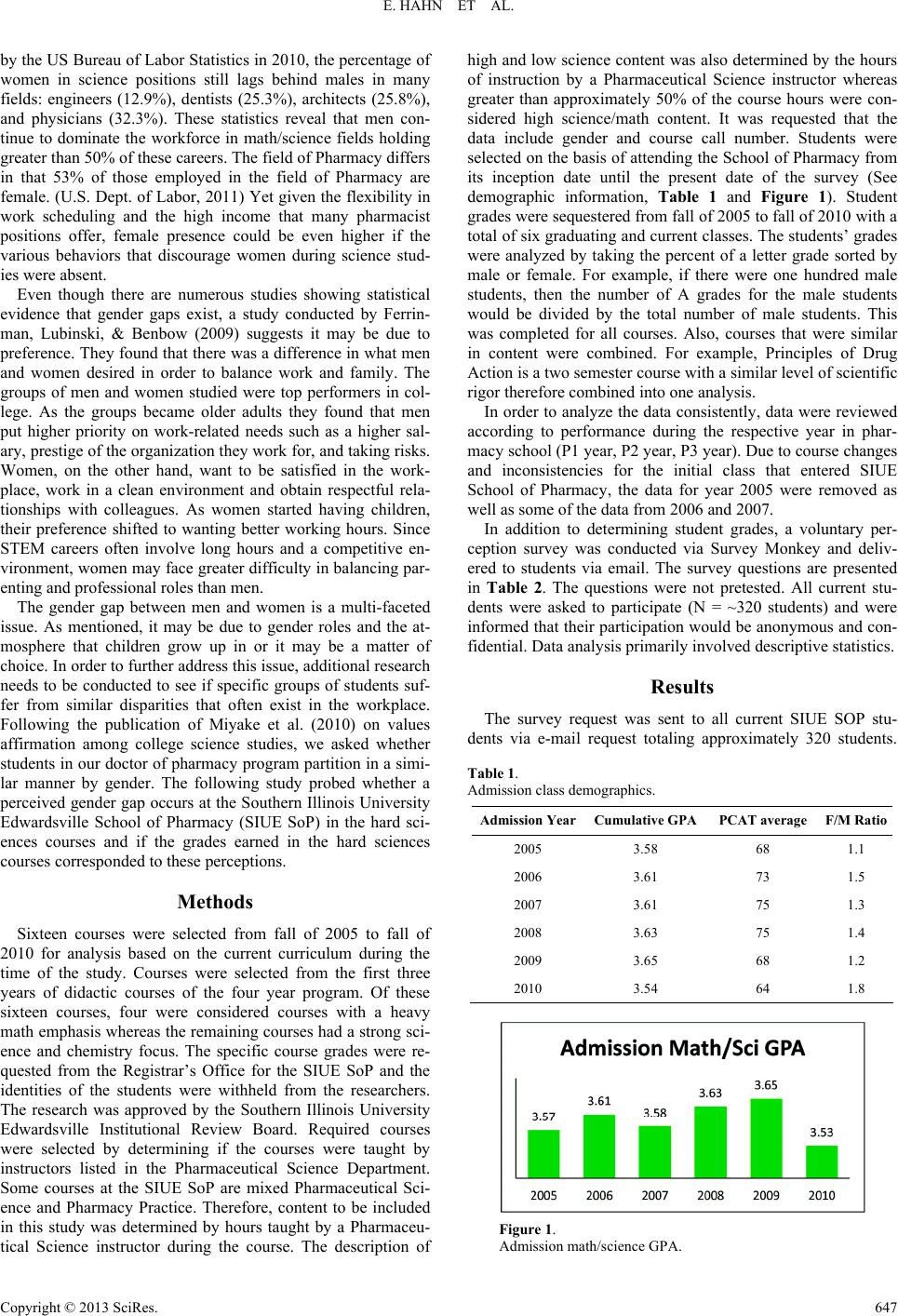
E. HAHN ET AL.
by the US Bureau of Labor Statistics in 2010, the percentage of
women in science positions still lags behind males in many
fields: engineers (12.9%), dentists (25.3%), architects (25.8%),
and physicians (32.3%). These statistics reveal that men con-
tinue to dominate the workforce in math/science fields holding
greater than 50% of these careers. The field of Pharmacy differs
in that 53% of those employed in the field of Pharmacy are
female. (U.S. Dept. of Labor, 2011) Yet given the flexibility in
work scheduling and the high income that many pharmacist
positions offer, female presence could be even higher if the
various behaviors that discourage women during science stud-
ies were absent.
Even though there are numerous studies showing statistical
evidence that gender gaps exist, a study conducted by Ferrin-
man, Lubinski, & Benbow (2009) suggests it may be due to
preference. They found that there was a difference in what men
and women desired in order to balance work and family. The
groups of men and women studied were top performers in col-
lege. As the groups became older adults they found that men
put higher priority on work-related needs such as a higher sal-
ary, prestige of the organization they work for, and taking risks.
Women, on the other hand, want to be satisfied in the work-
place, work in a clean environment and obtain respectful rela-
tionships with colleagues. As women started having children,
their preference shifted to wanting better working hours. Since
STEM careers often involve long hours and a competitive en-
vironment, women may face greater difficulty in balancing par-
enting and professional roles than men.
The gender gap between men and women is a multi-faceted
issue. As mentioned, it may be due to gender roles and the at-
mosphere that children grow up in or it may be a matter of
choice. In order to further address this issue, additional research
needs to be conducted to see if specific groups of students suf-
fer from similar disparities that often exist in the workplace.
Following the publication of Miyake et al. (2010) on values
affirmation among college science studies, we asked whether
students in our doctor of pharmacy program partition in a simi-
lar manner by gender. The following study probed whether a
perceived gender gap occurs at the Southern Illinois University
Edwardsville School of Pharmacy (SIUE SoP) in the hard sci-
ences courses and if the grades earned in the hard sciences
courses corresponded to these perceptions.
Methods
Sixteen courses were selected from fall of 2005 to fall of
2010 for analysis based on the current curriculum during the
time of the study. Courses were selected from the first three
years of didactic courses of the four year program. Of these
sixteen courses, four were considered courses with a heavy
math emphasis whereas the remaining courses had a strong sci-
ence and chemistry focus. The specific course grades were re-
quested from the Registrar’s Office for the SIUE SoP and the
identities of the students were withheld from the researchers.
The research was approved by the Southern Illinois University
Edwardsville Institutional Review Board. Required courses
were selected by determining if the courses were taught by
instructors listed in the Pharmaceutical Science Department.
Some courses at the SIUE SoP are mixed Pharmaceutical Sci-
ence and Pharmacy Practice. Therefore, content to be included
in this study was determined by hours taught by a Pharmaceu-
tical Science instructor during the course. The description of
high and low science content was also determined by the hours
of instruction by a Pharmaceutical Science instructor whereas
greater than approximately 50% of the course hours were con-
sidered high science/math content. It was requested that the
data include gender and course call number. Students were
selected on the basis of attending the School of Pharmacy from
its inception date until the present date of the survey (See
demographic information, Table 1 and Figure 1). Student
grades were sequestered from fall of 2005 to fall of 2010 with a
total of six graduating and current classes. The students’ grades
were analyzed by taking the percent of a letter grade sorted by
male or female. For example, if there were one hundred male
students, then the number of A grades for the male students
would be divided by the total number of male students. This
was completed for all courses. Also, courses that were similar
in content were combined. For example, Principles of Drug
Action is a two semester course with a similar level of scientific
rigor therefore combined into one analysis.
In order to analyze the data consistently, data were reviewed
according to performance during the respective year in phar-
macy school (P1 year, P2 year, P3 year). Due to course changes
and inconsistencies for the initial class that entered SIUE
School of Pharmacy, the data for year 2005 were removed as
well as some of the data from 2006 and 2007.
In addition to determining student grades, a voluntary per-
ception survey was conducted via Survey Monkey and deliv-
ered to students via email. The survey questions are presented
in Table 2. The questions were not pretested. All current stu-
dents were asked to participate (N = ~320 students) and were
informed that their participation would be anonymous and con-
fidential. Data analysis primarily involved descriptive statistics.
Results
The survey request was sent to all current SIUE SOP stu-
dents via e-mail request totaling approximately 320 students.
Table 1.
Admission class demographics.
Admission YearCumulative GPA PCAT average F/M Ratio
2005 3.58 68 1.1
2006 3.61 73 1.5
2007 3.61 75 1.3
2008 3.63 75 1.4
2009 3.65 68 1.2
2010 3.54 64 1.8
Figure 1.
Admission math/science GPA.
Copyright © 2013 Sci R e s. 647